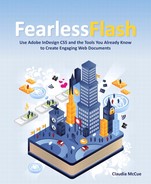Chapter 4. Animation
While previous versions of InDesign allowed you to create hyperlinks and import video and sound files, the InDesign document itself was static; none of the page content wiggled or barked. While InDesign CS4 introduced the ability to import SWF files and to export to the SWF format, the resulting SWF was still just a container for content that had to be created elsewhere. But InDesign CS5 allows you to do so much more—now, page content itself can be animated. Here’s where the real fun begins!
What Can Be Animated?
Any text frame, graphics frame, or empty frame (or group of frames) can be animated. As you saw in Chapter 3, “Multimedia,” a frame containing an FLV or FV4 video can be animated, but the video inside the frame won’t play until the animated frame calms down and stops doing whatever it’s doing. However, remember that a frame containing a placed SWF file can be animated, and the animation inside the frame will play while its container is doing something else (as long as something triggers the SWF to play). Think of the fiendish possibilities!
Exploring the Possibilities
There’s a great little guide to InDesign’s animation capabilities built right into the application, but you have to do a little digging to find it. First, you have to find a script that ships with InDesign. The script generates an InDesign document containing examples of objects using many of the animation controls. You can examine each object’s settings in the Animation and Timing panels and learn a lot.
- To start your quest for the Animation Encyclopedia (its official name), open the Scripts panel (Window > Utilities > Scripts). You’ll see two folders: Application and User. The User folder stores scripts you download to add to InDesign’s functionality (the scripts displayed are those installed by the currently active computer user); the Application folder contains the scripts that ship with InDesign (Figure 4.1).
Figure 4.1. Sample scripts are supplied in two formats for Windows (JavaScript and VBScript) and two formats for Mac (JavaScript and AppleScript). All application scripts are available in both formats; only JavaScript is cross-platform.
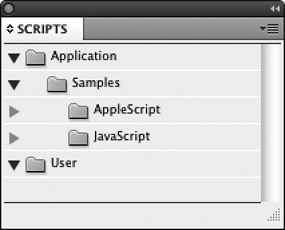
- You’ll have to keep digging. Click the triangle next to the Application folder to view the Samples folder. Here’s where the road forks: If you’re using Windows, you’ll see subfolders for VBScript and JavaScript; on the Mac, you’ll have subfolders for AppleScript and JavaScript. The script selection is actually the same in both subfolders, so it doesn’t matter which you select for the next step; you’re almost there. Click the triangle next to JavaScript, VBScript, or AppleScript, and there it is (finally): AnimationEncyclopedia (Figure 4.2).
Figure 4.2. You’ll find the AnimationEncyclopedia script in the JavaScript, AppleScript, or VBScript folder (depending on your platform). You’ll see VBScript on Windows, and AppleScript on the Mac. JavaScript is cross-platform.
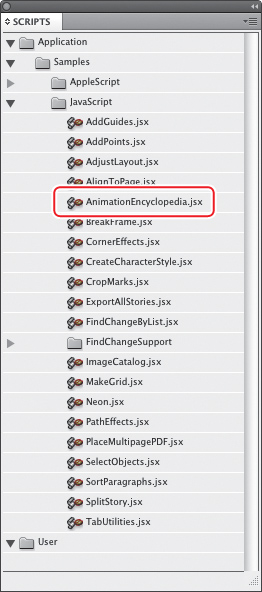
- Double-click the script to run it. InDesign takes the reins and builds a six-page document. It may not look very exciting at first (Figure 4.3), but it packs a secret punch. Preview the document and play along. Some objects require that you click them or the page, and some will be triggered when the page loads.
Figure 4.3. The design of the Animation Encyclopedia may not be compelling, but the beauty is under the hood. Preview this simple document, and prepare to be amazed.
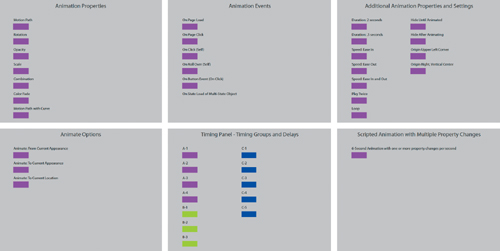
The document that’s created is named Untitled.indd; I suggest you save it as AnimationEncyclopedia.indd and put it in a safe place. You can learn a lot about InDesign’s animation capabilities by examining the settings used by those little rectangles. Just so you know, page 6 of the document displays very complex behavior that’s beyond what you can do with just the animation and timing settings; it’s accomplished with scripting (as are the Color Fade and Combination effects on page 1). To give you an idea of its complexity, look at an excerpt from the JavaScript version of the Animation Encyclopedia script (Figure 4.4).
Figure 4.4. Scripting can accomplish complex animations far beyond what’s possible with the motion and timing controls.
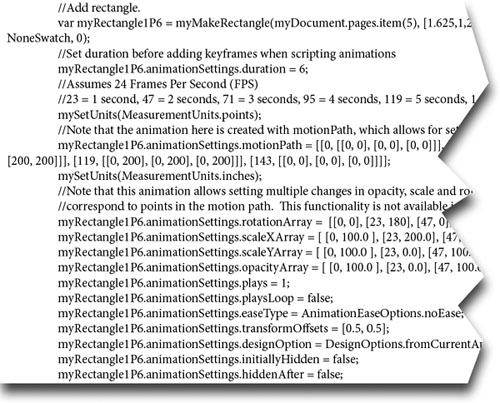
Don’t freak out—you’re not expected to write code like this! All the behaviors you see on pages 1 through 5 of the encyclopedia—and many more—can be achieved by using the controls and options in the Animation and Timing panels. The inclusion of the over-the-top performance on page 6 is to expose you to the fact that animation, like every other operation in InDesign, is completely scriptable. For this and other reasons, it’s a good idea to befriend a scripter and take him/her to lunch occasionally.
Events
An animation requires two components: the object or objects being animated, and an event to trigger the playing of the animation. The triggering event could be the click of a button, a click of the animated object itself, or just the loading of the page on which the animation was created. Now you’ll do some exploring, so you can see how easy it is to make simple objects do your bidding.
On Page Load
The default animation-triggering event is the simplest: The animation plays when the reader reaches the page (or opens the document, if the page is the first—or only—page).
- Launch InDesign, navigate to the Ch_4_Exercises folder, and open Events_Start.indd. Before changing anything in the file, resave the file as Events_Working.indd. If necessary, choose the Interactive workspace from the Control panel (unless you have a custom panel arrangement for the interactive panels and don’t want to alter that).
- Notice the caption beneath each object, describing the trigger that will set the object’s animation in motion (Figure 4.5). Select one of the objects and look in the Animation panel; nobody home. You’ll create the animations and set up the event triggers. If you’re curious, you can preview a finished version of the file in the exercises folder (Events_Done.indd).
Figure 4.5. The caption under each object specifies the event that will trigger the object’s animation. You’ll create each animation behavior and set up the event triggers.

- Select the green globe with the “On Page Load” caption and open the Animation panel. Rename the object GreenGlobe. (It’s helpful to give objects names you’ll recognize when you set up animations.) While each object in this page is unique, how would you address the correct circle in a page full of circles? By its name, of course. By the way, renaming the object in the Animation panel also changes its name in the Layers panel (and vice versa).
- In the Animation panel, choose Fly in from Top from the Preset pull-down menu. A charming lavender butterfly demonstrates the animation for you. The Event option should already be set to the default, On Page Load (Figure 4.6). If you don’t see all the options, click the triangle to the left of Properties to reveal more of the panel. Leave all the other options at their defaults. Check the results in the Preview panel (Window > Interactive > Preview). Save the file and keep it open. There’s more fun to be had.
Figure 4.6. Set the GreenGlobe object to fly in from the top of the page on page load.
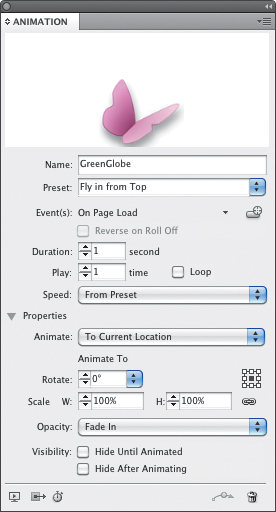
On Page Click
You may find that you rarely use the On Page Click event as a trigger for animation, since a reader probably wouldn’t feel the urge to click the page unless invited to do so. Artwork or text would have to give the reader a hint, or nothing would ever happen. But you never know when it might come in handy, so here goes.
- Select the embossed orange square, and then choose Fly Out > Fly Out Top from the Preset pull-down menu (the Fly Out Top option is available in the submenu of the Fly Out option).
- The Events pull-down menu control isn’t obvious; it’s a tiny triangle about an inch to the right of the Event(s) label in the Animation panel, and it comprises about six pixels. Squint a bit, and you’ll find it (Figure 4.7). The triangle is a small target, but you can activate it by clicking the name of the existing event: On Page Load. (You can also click a bit to the left of the pull-down triangle and activate it.)
Figure 4.7. The Event options are available when you click the tiny triangle to the right of the Event(s) option. Could it be any more subtle?
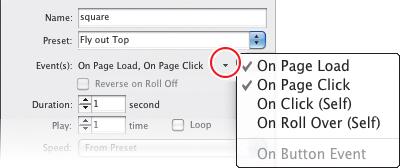
Once you’ve found the miniature triangle, click it and choose On Page Click from the menu.
- IMPORTANT: Choosing the On Page Click option does not override the original On Page Load trigger; this is easy to overlook when you’re in a hurry. Go back to the same menu and select On Page Load to toggle it off. Otherwise, the orange square will fly upward when the page loads, before the user has an opportunity to click the page, thus spoiling the surprise. In the Preview panel, wait for the green globe to fly in from the top, and then click in the Preview panel to set the orange square in motion. Be sure to click in an empty part of the page (despite the temptation to click on the orange square) to prove to yourself that it’s the page click that does the trick. Save the file and keep it open.
On Click (Self)
If you want the reader to click on an object to wake it up, use the On Click (Self) event. The term may seem odd; after all, the object can’t click itself. But it just means that the animation is triggered by clicking the object itself, rather than by clicking an external trigger.
- Select the red heart-shaped object, and change its name to Heart in the Animation panel. Choose the Pulse animation from the Preset pull-down (it’s in the bottom part of the long list of presets).

- Now that you’ve found the elusive Events pull-down triangle, choose the On Click (Self) option. Be sure to go back and toggle the default On Page Load option off.
- Test the file in the Preview panel; click the heart and watch it beat hypnotically. If you like, experiment with the duration of the pulse, and set the number of times to 2 or 3. Remember this around Valentine’s Day (or Halloween). Save the file and keep it open.
As with the On Page Click option, something has to lure the reader to click on the object to trigger its animation. While a “Click Me!” label might be a bit inelegant, something must provide a hint, or the heart will never have a chance to beat.
On Roll Over (Self)
Now that you know that “(Self)” refers to the animated object itself, it’s obvious that the On Roll Over (Self) event triggers an animation when the reader rolls over the animated object. You’ll use the rollover event to make the blue half-circle spin around.
- Select the blue object, and change its name to HalfCircle in the Animation panel. Choose the On Roll Over (Self) event, and then choose the Rotate > Rotate 180° CW option from the Preset pull-down menu. Remember to toggle the On Page Load event off. Test the half-circle in the Preview panel.
- Try holding the mouse on the half-circle, and you’ll see that the half-circle keeps rotating. That’s one oddity about using the rollover event as the trigger for an animation that keeps an object in the same location: If the user doesn’t move the mouse away from the object, the animation is repeatedly triggered. Save the file and keep it open.
Note that when you choose the On Roll Over (Self) event, a new option appears in the Animation panel: Reverse on Roll Off. This would reverse (or undo) the animation move caused by the Roll Over event. For example, if the Reverse on Roll Off option is checked and you rotate an object 90 degrees clockwise by rolling over it, the object will rotate back to its original orientation when you roll off it.
On Button Event
One of the most common methods you’ll use to trigger an animation is a button click. You must create the animation (even if it’s just a temporary version of the animation) before setting up the button, or the button has nothing to hook up to. (In Chapter 5, “Button Up,” you’ll learn how to create cool button artwork in Adobe Photoshop, Adobe Illustrator, and Adobe InDesign.)
- Select the purple doughnut shape. Name it Doughnut in the Animation panel, and select the Grow option from the Preset pull-down. Set the scale factor to 150%, and choose the On Page Load event to toggle it off, in preparation for triggering the growing animation with a button.
- Select the gray button in the bottom right corner of the page, and open the Buttons panel (Window > Interactive > Buttons) to set it up. Choose the default On Release event, and click the plus sign next to Actions to select Animation (in the SWF section of the menu).
- Note that when you select the Animation action, the panel changes in response, adding a pull-down menu that allows you to select which animation is triggered, and to select from options including Play, Stop, Pause, and Resume. Select the Doughnut animation and the default Play option. Test the file in the Preview panel. Export the file if you’d like to view it in a browser. You’re finished with this exercise, so you can save the file for future reference and then close it.
Tip
You can also create a relationship between the animation and the button right in the Animation panel. Click the Create Button Trigger icon (![]() ) in the Animation panel, and then click the button that will act as the trigger. If the trigger object is not yet a button, you’re given the opportunity to make it a button.
) in the Animation panel, and then click the button that will act as the trigger. If the trigger object is not yet a button, you’re given the opportunity to make it a button.
Think about how the animated piece is presented, either in the Preview panel or in a browser. You knew where and what to click, because you were adding the interactive features. But would a reader, stumbling onto your Web page, know where to click? Probably not. This exercise was meant to familiarize you with the controls and options, not to create a final piece that would be published online. But when you start creating your own animations, you’ll have to provide hints to the reader so they don’t miss out on some of the fun, especially if the animated objects are hidden when the reader first views the document.
Combining Animations
If you were intrigued by the multiple behaviors of the object on page 6 of the Animation Encyclopedia, but don’t have the time or inclination to learn scripting, you can cheat. I mean, use a workaround.
An animated object can be grouped with other objects, and then the group can be animated, resulting in a second behavior added to the original animation. Buttons can be grouped with other objects in a group that becomes animated, giving you the ability to make buttons move. You can keep nesting animations inside animations until... well, as long as your conscience will allow.
- In the Ch_4_Exercises folder, open MultiMoveStart.indd. Resave the file as MultiMoveWorking.indd in the same folder. The objects in the page have already been named in the Layers panel, which will save you some time (approximately half a second) when you animate them. If you like, preview the finished version of the project, MultiMoveDone.indd.
- Select the yellow star with a solid red stroke. In the Animation panel, choose the Grow preset, set the Duration to 2 seconds, and set the final scale factor to 200%. Be sure that the center point is selected in the scale orientation control (
 ) in the Animation panel, so the star scales up from the center. Test the growing star in the Preview panel.
) in the Animation panel, so the star scales up from the center. Test the growing star in the Preview panel. - Select the light-blue square, and send it behind the star in stacking order: Object > Arrange > Send to Back. Select the light-blue square and center it under the yellow star (Smart Guides can make this easy). If you’re not sure the blue square and yellow star are perfectly centered, select them both, open the Align panel (Window > Object & Layout > Align), and use the vertical and horizontal center operations (Figure 4.8). It’s even easier to use the alignment icons in the Control panel.
Figure 4.8. Make sure the yellow star is perfectly centered on the blue square by clicking the Align Horizontal Centers icon and then the Align Vertical Centers icon in the Align panel.

- Now you’ll start piling on the animations. Group the blue square and yellow star together, and snap the group to the lower-left corner of the page. In the Animation panel, rename the group StarSquare, choose the Fly In From Top preset, and set the Duration to 2 seconds. The intention is to have the star-and-square group drop in from the top of the page, while the star scales simultaneously. But when you preview the animation, it clearly needs more work. You need to modify the length of the fly-in from the top of the page, as well as synchronize the fly-in and the scaling of the star.
- If necessary, reselect the group so you can see the bright green fly-in path (Figure 4.9). Notice that it has little nodes. Yes, this means that you can edit any motion path. Click the path (the “bulb” at the top is probably the easiest target), and you’ll see a narrow bounding box appear around the path. The goal is to stretch the top anchor point on the path up to the top edge of the page. Pull up on the top anchor point—and it snaps back to its original position. Aargh! (This is a peculiarity of the Fly in from Top and Fly in from Bottom presets.)
Figure 4.9. The anchor points provide a hint that you can edit the motion path just like any other Bézier path.
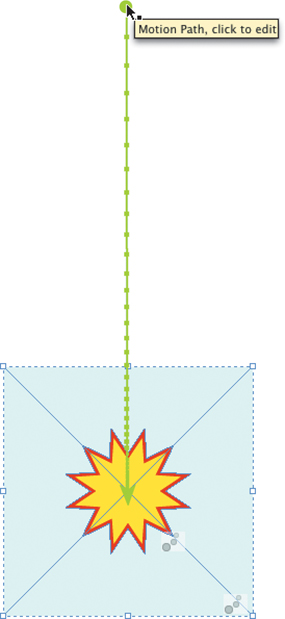
Here’s the trick: Switch to the Direct Selection tool (white arrow). The bounding box disappears, and the motion path now appears as a hairline. Click on the tiny top anchor point, hold down the Shift key (lest the path wander left or right), and drag straight up until you touch the top edge of the page. You can also set up the length and position of the motion path in the measurements fields in the Control panel, but you may find selecting and dragging easier and more intuitive.
- The star should grow as the star-and-square group falls from the top of the page, so you’ll have to synchronize the star’s growth with the square’s fall. Switch back to the black arrow, and reselect the group. In the Timing panel, Shift-click to select both the tacky star and StarSquare animations, and click the link icon to synchronize them (Figure 4.10). Now, the scaling of the star and the group’s aerial drop will occur simultaneously. Preview the results, save the file, and keep it open for the grand finale.
Figure 4.10. Select the tacky star and StarSquare animations and synchronize them by clicking on the small link icon at the bottom of the Timing panel.
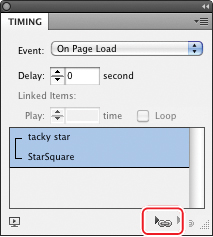
- Now you’ll add another animation, to send the star-and-square group flying off the page to the right. Select the empty rectangle on the page, and move it to the lower-left corner so it’s aligned with the star-and-square group; the lower-left corner of the group should be aligned with the lower-left corner of the page. Select all the objects and group them (Object > Group).
- In the Animation panel, name the new group FinalGroup, and choose the Fly Out > Fly Out Right preset. You’ll have to edit the preset motion path so that the FinalGroup flies all the way off the right side of the page.
- If necessary, select the FinalGroup object so you can see its bright-green motion path. Unlike the Fly in from Top motion path, this path can be edited without switching to the Direct Selection tool (only the Fly In from Top and Fly In from Bottom presets have this limitation). Select the path itself, click the green arrowhead on the end of the path, and drag the arrowhead to the right until it’s far enough off the page that the star-and-square group will disappear at the end of its travel. Look up in the Control panel; the total length of the path (the “L” field) should be about 425 px.
- You’ll make one last change; rather than having the star-and-square group fade out as it exits, you’ll keep it solid. In the Animation panel, change the Opacity setting from Fade Out to None. Preview the final animation, tweak if you want, and then save and close the file.
This is just a simple example, but it gives you an idea of what’s possible without learning how to script InDesign. I don’t mean to imply that this is a good thing to do, from a design standpoint; this is one of those “just because you can, doesn’t mean you should” situations. The potential for garish, annoying animations is limitless. I feel guilty even showing this to you (you’re welcome).
Motion Presets
As you probably noticed while working through the previous exercises, InDesign includes an extensive assortment of motion presets to get your content moving (Figure 4.11). The presets are the same ones you’ll find in Adobe Flash CS5 Professional, and you can also import any custom presets that have been created in Flash Professional. You can create custom motion presets in InDesign, save them for future use, and share them with other InDesign users or Flash designers. There’s just no end to the flying, dancing, bouncing fun you can have with motion settings.
Figure 4.11. How many motion presets ship with InDesign? Feast your eyes. And restrain yourself—you don’t have to use every single one in your project. The motion presets below the dividing line include special effects such as multiple stops or disappearing in smoke.
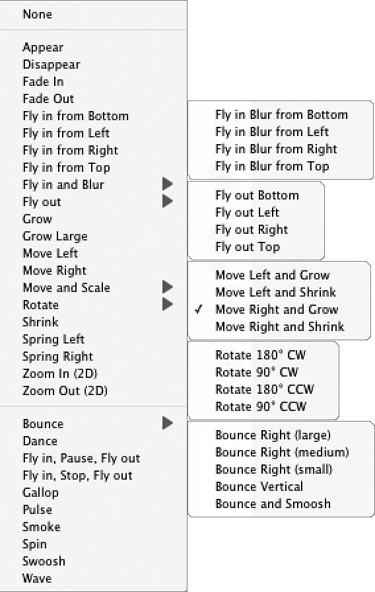
But maybe that’s not enough for you. Maybe you want more.
Motion Paths
If you want to make an object move along a more interesting path than just straight up or left to right, it’s surprisingly easy to do: You just have to draw the path you want the object to follow. You can use the Line tool, the Pen tool, or the Pencil tool—anything that creates a Bézier path. The path can be a simple straight line or a complicated curlicue. The stroke attributes of the line aren’t important; its appearance is discarded once it’s designated as a motion path.
Creating a Custom Motion Preset
In this exercise, you’ll work on a child’s birthday party invitation, modifying existing presets and saving them as custom presets. You will also be creating several custom motion paths and saving their settings as custom presets.
- Navigate to the Motion Presets folder inside the Ch_4_Exercises folder, and open InviteStart.indd. Resave the file as InviteWorking.indd in the same folder. If you want to see the finished file, open InviteDone.indd and preview it.
- In the Layers panel, make sure the Moon layer is selected and unlocked. Select the Line tool (
 ), and draw a diagonal line from the center of the blue moon to the upper-right corner of the page (Figure 4.12). Leave some room for the moon to grow larger as it rises.
), and draw a diagonal line from the center of the blue moon to the upper-right corner of the page (Figure 4.12). Leave some room for the moon to grow larger as it rises.
Figure 4.12. Using the Line tool, start at the center of the moon, and drag up to the upper-right corner of the page. Don’t go all the way to the corner; leave some room for the moon to grow larger.
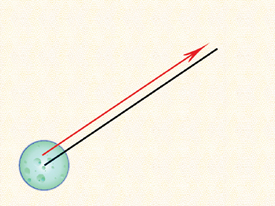
- Now you’ll convert the diagonal line to a motion path. Select both the path and the moon, and click the Convert to Motion Path icon (
 ) at the bottom of the Animation panel. Use the following settings:
) at the bottom of the Animation panel. Use the following settings:
• Event: On Page Load
• Duration: 2 seconds
• Speed: Ease Out
• Animate: From Current Appearance
• Animate Scale: 150%
• Visibility: Hide Until Animated
These settings will hide the moon until it begins to rise and grow larger. If necessary, tweak the length and angle of the path—you have to allow for the increase in the diameter of the moon so it isn’t cropped by the edge of the page.
- Lock the Moon layer, and click the visibility control by the Once in a Blue Moon layer to make it visible. Select the layer to target it.
- Using either the Pen or the Pencil tool, create a curved path that will bring the “Once in a Blue Moon” text in along a short counterclockwise arc (Figure 4.13). Start below the text, and end the curved path near the center of the text. You’ll designate this path as a motion path after you choose the initial motion preset.
Figure 4.13. Create a short, counterclockwise arc to guide the blue text up to the top of the page.

- In the Animation panel, choose the Fade In preset as a start, and use the following settings:
• Event: On Page Load
• Duration: 2.5 seconds
• Speed: From Preset
• Animate: To Current Location
• Animate Scale: 120%
• Visibility: Hide Until Animated
- Select the arc path and the text (which have already been converted to outlines), and click the Convert to Motion Path icon at the bottom of the Animation panel.
- The moon should start rising, followed by the appearance of the text. Use the Timing panel to control when each component plays. Select both animations in the Timing panel, and click the Play Together link at the bottom of the panel (Figure 4.14). (Ignore the existing animation in the Timing panel; it will make its appearance later in the exercise.) Preview the animation, save the file, and keep it open.
Figure 4.14. Synchronize the moonrise and the blue text so they play together.
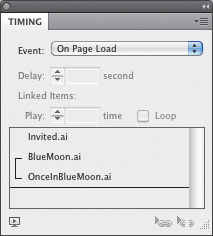
- Now you’ll create a motion path and save it as a custom preset that you can use for other objects. Hide the Party, Once in a Blue Moon, and Moon layers. Reveal the Balloons layer, and select it to target it. With the Pen or Pencil tool, create an S-shaped path that starts at the center of the green-and-purple balloon and stops short of the top of the page (Figure 4.15). You’ll probably want to tweak the path after you test the animation; you want the balloon to float upward, but not off the page. Remember that the stroke attributes of the path aren’t important; it becomes invisible once it’s designated as a motion path.
Figure 4.15. Create an S-shaped path for the green-and-purple balloon to follow as it floats upward.
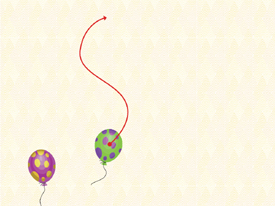
- Select the balloon and the path, and click the Convert to Motion Path icon at the bottom of the Animation panel. Use the following settings:
• Event: On Page Load
• Duration: 3 seconds
• Speed: None
• Animate: From Current Appearance
• Animate Scale: 100%
• Opacity: Fade Out
- To save the balloon motion as a motion preset, choose Save from the Animation panel menu. Name the motion preset Balloon Float in the Save Preset dialog (Figure 4.16) and click OK.
Figure 4.16. Name your new motion preset.

- Now you’ll apply the new custom motion preset to the other balloon. Select the purple-and-yellow balloon, and choose the Balloon Float preset in the Animation panel; notice that it’s displayed in a separate part of the Preset pull-down menu, near the top. That’s where your custom presets will appear. Examine the settings. Everything you specified for the first balloon has been stored in the preset, giving you a big head start on the second balloon. Change one thing: Set the Opacity to None, so the second balloon doesn’t fade out.
- Preview the animation. Reposition the purple-and-yellow balloon if it flies off the left side of the page. If you wish to edit the balloon’s motion path, select the balloon, then switch to the white arrow and select the motion path. Once it’s selected, you can move, add, or delete anchor points to change its travel. Such edits will not alter the custom motion preset you created—the changes will apply just to this balloon’s animation.
- It would be nice if the second balloon appeared in front of the text at the top of the invitation. In the Layers panel, turn the visibility of the Once in a Blue Moon layer back on, and unlock the layer. Select the purple-and-yellow balloon in the Balloons layer, and use the small blue target square in the Balloons layer to push the balloon up to the topmost layer (Figure 4.17).
Figure 4.17. Move the purple-and-yellow balloon up to the Once in a Blue Moon layer by pushing the blue target square up to the top layer.
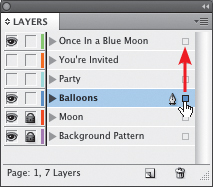
- Reveal the Party layer, and select the “We Have a Party” text. In the Animation panel, choose the Fade In preset and use the following settings:
• Event: On Page Load
• Duration: 3.5 seconds
• Speed: From Preset
• Animate: From Current Appearance
• Animate Scale: 200%
• Opacity: Fade In
• Visibility: Hide Until Animated
- Finally, reveal all layers. The text in the You’re Invited layer has already been animated. All you have to do is slightly rearrange the order in the Timing panel and link most of the animations together.
- In the Timing panel, drag the Invited.ai animation to the bottom of the list. Drag balloon.ai and balloon2.ai up in the timing list so they’re just below BlueMoon.ai (Figure 4.18). Select all of the animations except Invited.ai, and link them so they start together on page load. They have different durations, so they don’t all finish simultaneously. Preview the animation, save the file, and keep it open.
Figure 4.18. Arrange the animations in the Timing panel as shown. Link all the animations except Invited.ai.
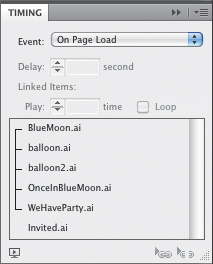
Exporting and Importing Motion Presets
Motion presets are not document-specific. When you save a preset, it becomes part of InDesign’s arsenal for all documents. You should save the Balloon Float preset in case you ever need it again.
- From the Animation panel menu, choose Manage Presets. Select the Balloon Float preset at the top of the list, and then click the Save As button. You can save motion presets anywhere; they’re just XML files. Navigate to the Motion Presets folder inside the Ch_4_Exercises folder, name the preset BalloonFloat.xml, and click Save. You have to save presets one at a time, so if you want to store multiple custom presets, you’ll have to export them like this, one by one. Keep the Manage Presets dialog open for the next step.
- So you’ll know how to import custom motion presets, you’ll delete the Balloon Float preset and then re-import it. Select the Balloon Float preset and click the Delete button. InDesign warns you that there is no undo for this move (Figure 4.19); click OK.
Figure 4.19. InDesign warns you that deleting a motion preset in the Manage Presets dialog cannot be undone.
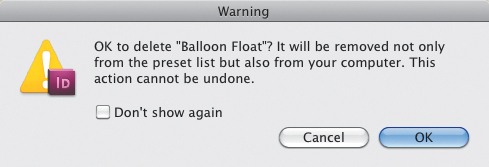
- Back in the Manage Presets dialog, click the Load button, navigate to the folder where you saved the BalloonFloat.xml file, select the file, and click Open. Although you must save presets one at a time, you can load multiple motion presets at once. Preview the file one last time, and tweak anything you’d like to change. You’re finished with this exercise; you can close the file.
In this exercise, you played with a number of motion presets, learned how to create and use a motion path, and learned how to save and load custom motion presets. You should feel more familiar with the controls in the Animation panel and the wonderful selection of motion presets InDesign gives you. You should also be starting to get a sense of how you can combine durations and animation order in the Timing panel to make things happen when you want. And it’s all pretty easy, isn’t it?
Page Transitions
As the user navigates from page to page in your project, it’s (usually) obvious to them that they’re reading through a multipage document. If you provide buttons that lead them to the next page, they’ll click on a “next page” button and the current page will be replaced by the next one (more about that in the next chapter). But if you’d like a fancier transition from one page to another, you might want to explore InDesign’s built-in page transitions. You may have seen the default Page Curl (way too cute), but there are others.
- In the Page Transitions folder inside the Ch_4_Exercises folder, open Paintings.indd. Resave the file as PaintingsWorking.indd in the same folder. Drag on the corner of the Preview panel so that you can more easily experiment with the default page curl, and set it to Preview Document mode (
 ). If necessary, click the Play triangle in the bottom left corner of the Preview panel to render the document. Hover your cursor over the upper-right or lower-right corner of the cover page of the project, and you’ll see the “paper” start to curl, much like a real magazine page. Hold down the mouse button and keep dragging toward the left side of the Preview window, and the experience is much like turning the page in a magazine printed on very thin paper (Figure 4.20). In fact, you may find it difficult to let go of the page in order to complete the transition to the next page—it’s sort of like that scene in National Lampoon’s Christmas Vacation when Chevy Chase is trying to read a magazine with pine sap on his hands. You’ll be relieved to know that the experience is much better in the exported SWF.
). If necessary, click the Play triangle in the bottom left corner of the Preview panel to render the document. Hover your cursor over the upper-right or lower-right corner of the cover page of the project, and you’ll see the “paper” start to curl, much like a real magazine page. Hold down the mouse button and keep dragging toward the left side of the Preview window, and the experience is much like turning the page in a magazine printed on very thin paper (Figure 4.20). In fact, you may find it difficult to let go of the page in order to complete the transition to the next page—it’s sort of like that scene in National Lampoon’s Christmas Vacation when Chevy Chase is trying to read a magazine with pine sap on his hands. You’ll be relieved to know that the experience is much better in the exported SWF.
Figure 4.20. The default SWF page curl is similar to turning pages in a printed magazine.
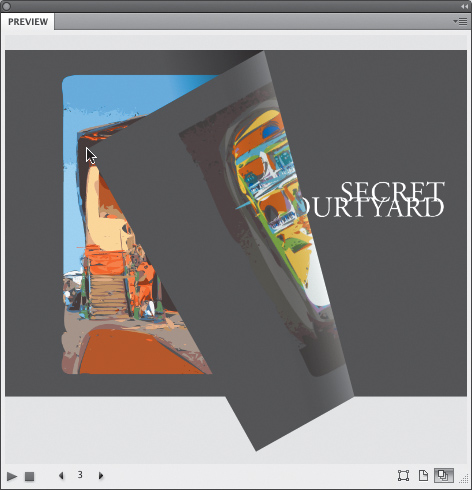
Note
If the page curl effect isn’t working in the Preview panel, choose Edit Preview Settings from the Preview panel menu, and make sure that the Include Interactive Page Curl option is checked. You may have to refresh the Preview panel by Alt/Option-clicking the play icon on the bottom of the panel.
- Launch your default Web browser, choose File > Open File, navigate to the PaintingsExport folder inside the Page Transitions folder, and open Paintings.html. Try turning the pages in your Web browser, and you should find that the page-turning behavior is much more natural. When you drag far enough toward the opposite side of the screen, the page should turn—and stay that way. Note that the page turn works whether you are paging forward or backward in the project, but only works when you click the corners, not on the straight edges of the page.
- Return to InDesign so you can explore more page transition options. If you rely on the page curl to take a reader from page to page, you may find you don’t need navigation buttons in a simple document. But you’ll have to make sure they know to peel the pages by the corners, and that isn’t obvious. You may decide that, however cute the page curl might be, you’d still like to provide buttons as a more obvious method of turning pages. But that doesn’t mean you can’t still entertain the user during the page-turning experience. It’s time to experiment with page transitions. In the Layers panel, reveal the Nav Buttons layer; “next page” and “previous page” buttons have already been created for you.
- In the Pages panel, select all seven page thumbnails. From the Pages panel menu, select Page Transitions > Choose to see the dozen page transition effects available (Figure 4.21). The examples themselves are animated; roll your cursor over one of the options to see the transition in action. Choose the Dissolve transition by clicking the radio button under its example, and click OK.
Figure 4.21. Page transition options. Roll over each option, and the example becomes animated to show you the effect. Note the option to apply to all spreads. All page transitions translate to interactive PDF except the Page Turn transition.
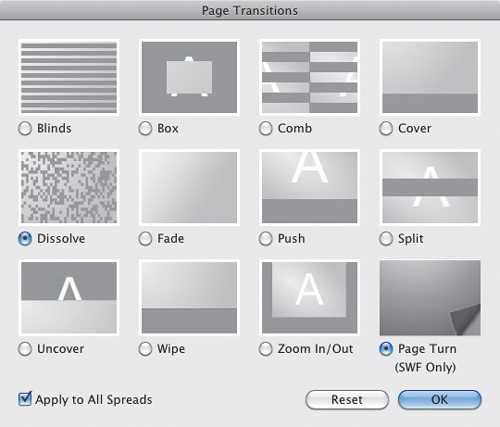
- If necessary, set the Preview panel to Preview Document mode. In the Preview panel menu, choose Edit Preview Settings and turn off the Include Interactive Page Curl option (Figure 4.22); the Page Curl option is on by default. Having the curl won’t prevent your page transition effects from working, but the cumulative effect of the Dissolve transition, the page curl, and the navigation buttons would probably be sensory overload for a reader. As they attempted to click the navigation button for the next page, the page would unexpectedly curl, then dissolve... well, it would just be too much. There’s something to be said for restraint.
Figure 4.22. To test page transitions, turn off the Include Interactive Page Curl option. Remember this option if you do want the page curl and wonder why it isn’t working (the option is on by default).
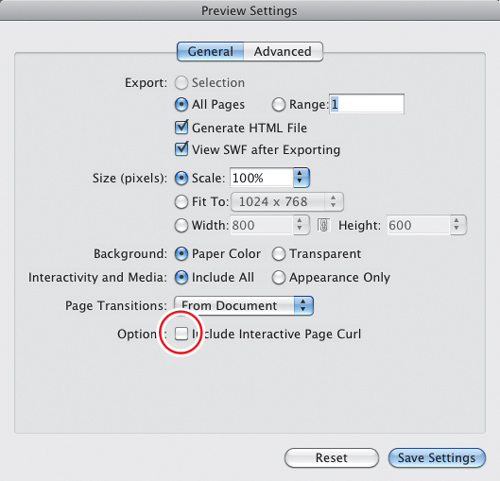
Click through the document in the Preview panel; what do you think of the Dissolve transition?
- If the twelve page transitions aren’t enough, you can customize the behavior of the transitions to shake things up (Figure 4.23). Open the Page Transitions panel (Window > Page Transitions), and select the Push transition. Click the Direction pull-down to see the options, and select the Right Up option. Click the Speed pull-down to see that you can choose from Slow, Medium, and Fast. Leave the Speed option at the default: Medium. Click the Apply to All Spreads icon in the lower-right corner of the panel, and check the results in the Preview panel.
Figure 4.23. You can customize page transitions by changing the speed and direction. Click the Apply to All Spreads icon (circled) if you neglected to select all spreads beforehand.

Experiment with other transitions; edit them to see what works best for this document. You can even apply a different transition to each page. (Remember: just because you can, that doesn’t mean you should. Control the urge.) Pages with a transition assigned will display a small icon in the Pages panel (Figure 4.24). You can also choose page transitions from Layout > Pages > Page Transitions > Choose (they just hide these little goodies everywhere, don’t they?).
Figure 4.24. A small icon (circled) indicates which pages have been assigned page transitions.
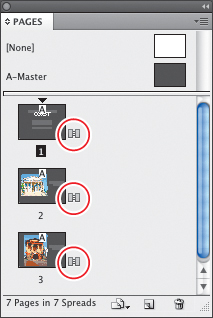
- Even if you pull on the corners of the Preview panel for a larger preview, you should still export to SWF and view the results in a browser for the full effect. What looks amusing in the Preview panel may prove to be overwhelming at full size in the final state. Decide on the page transition (or transitions) that you feel would be suitable for this small catalog of an artist’s work, and choose File > Export. Choose Flash Player (SWF) for the format, and navigate to the folder named Paintings (Your Version) inside the Page Transitions folder. Name the SWF Paintings.swf. In the export dialog, use the following settings:
• Generate HTML File: This enables you to view directly in a browser.
• View SWF after Exporting: Automatically displays the SWF in your default browser.
• Scale: 100%
• Background: Paper Color—even though the project has a charcoal gray background; if you check Transparent, page transitions won’t be included.
• Page Transitions: From Document, to preserve your choices. Note that you can select a transition from the pull-down menu, though, and override existing page transitions during export.
• Options: Uncheck the option to Include Interactive Page Curl.
- Page through the Paintings project in your browser and see what you think. Do you like the transition (or transitions) you chose? Do the page transitions enhance the reader’s experience, or do they compete for the reader’s attention, detracting from the paintings, which are the central subjects? You might even decide to dispense with the fancy transitions after all, and just let the reader move sedately from page to page using the navigation buttons. It’s up to you.
If you want to remove all page transitions and start over, select a page thumbnail (or multiple thumbnails) in the Pages panel and, from the panel menu, choose Page Transitions > Clear All. If you want to disable the page transition for a single page, the easiest way is to select the page thumbnail in the Pages panel, then right-click (Mac: Control-click) and choose Page Transitions > Clear Page Transition from the contextual menu.
Tip
Some of the animation effects may behave oddly when combined with a page transition—especially the page curl effect. You’ll get your first hint in the Preview panel. As you page through the project in the Preview panel, if animations are not appearing, or are behaving unexpectedly, test the file by exporting to SWF and previewing in a browser. You may find that you have to dispense with either the animation or the assigned page transition. Some of the more common animation offenders are Fade In, Appear, Zoom in 2D, Swoosh, and the Fly-in presets. It’s just One Of Those Things you’ll have to consider as you start creating more adventurous projects. The easiest way to combat this problem is to make it a habit to rely on buttons to navigate to the next or previous page, disabling all transitions, and let your animation imagination run wild.
